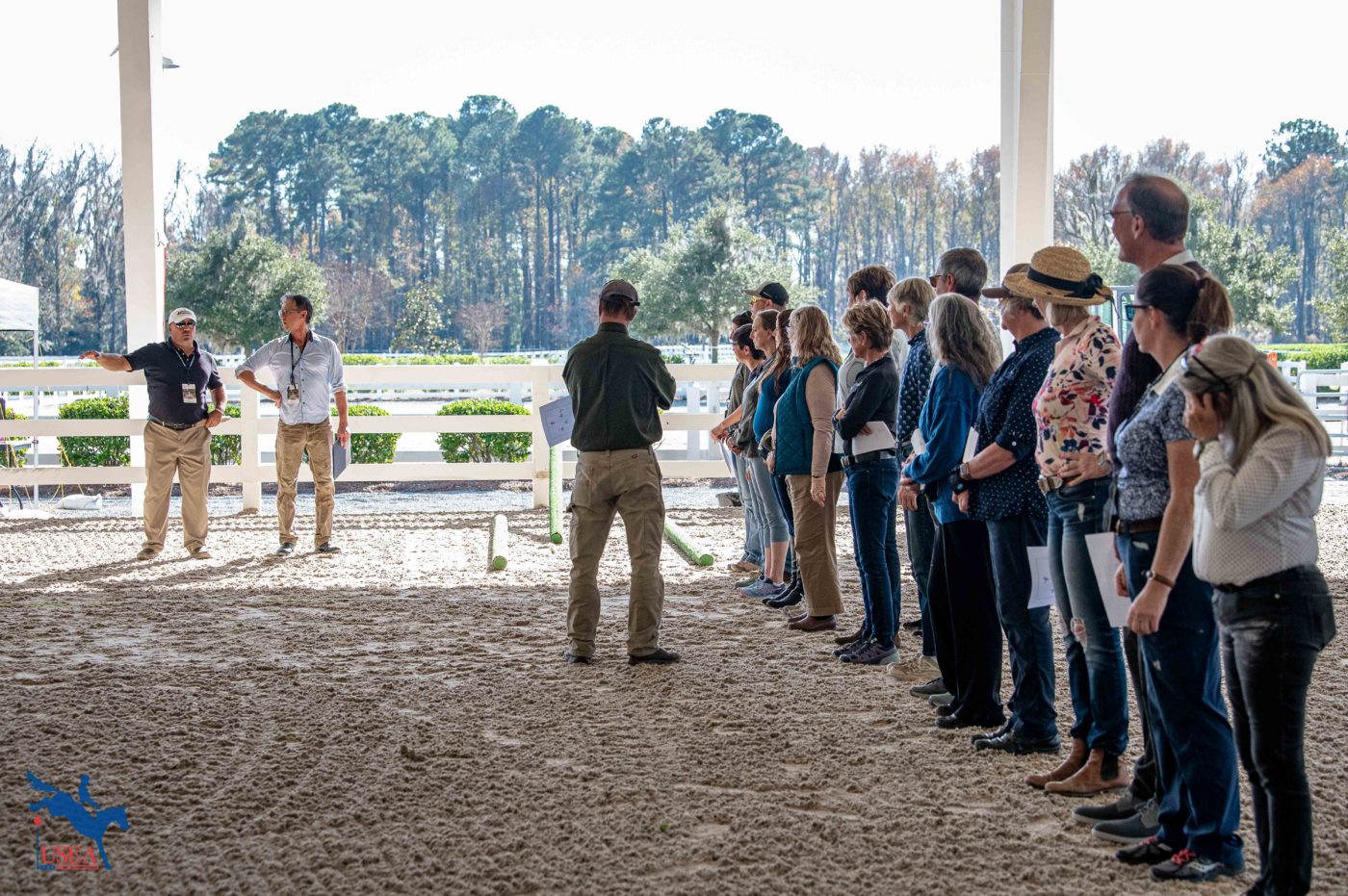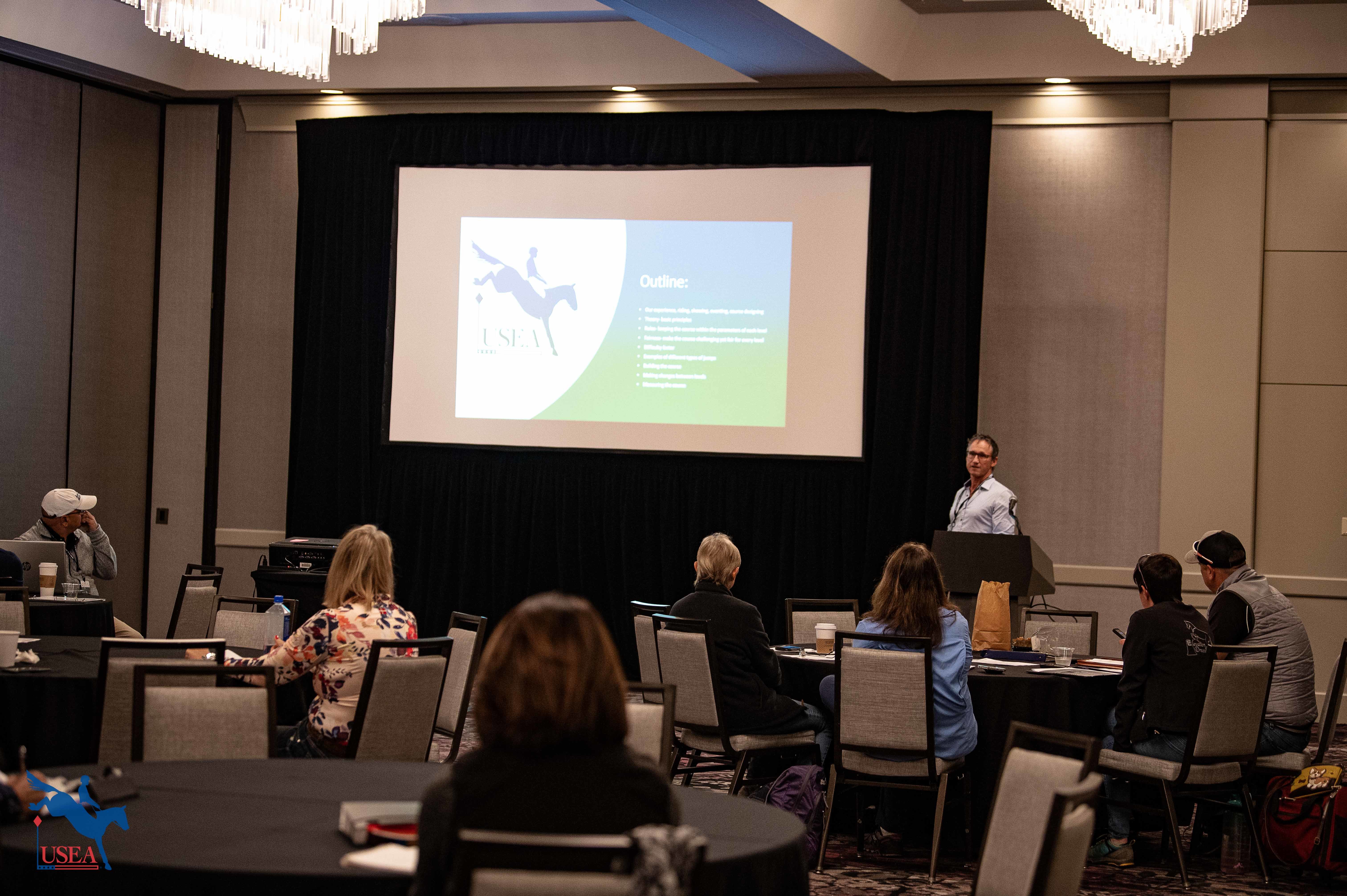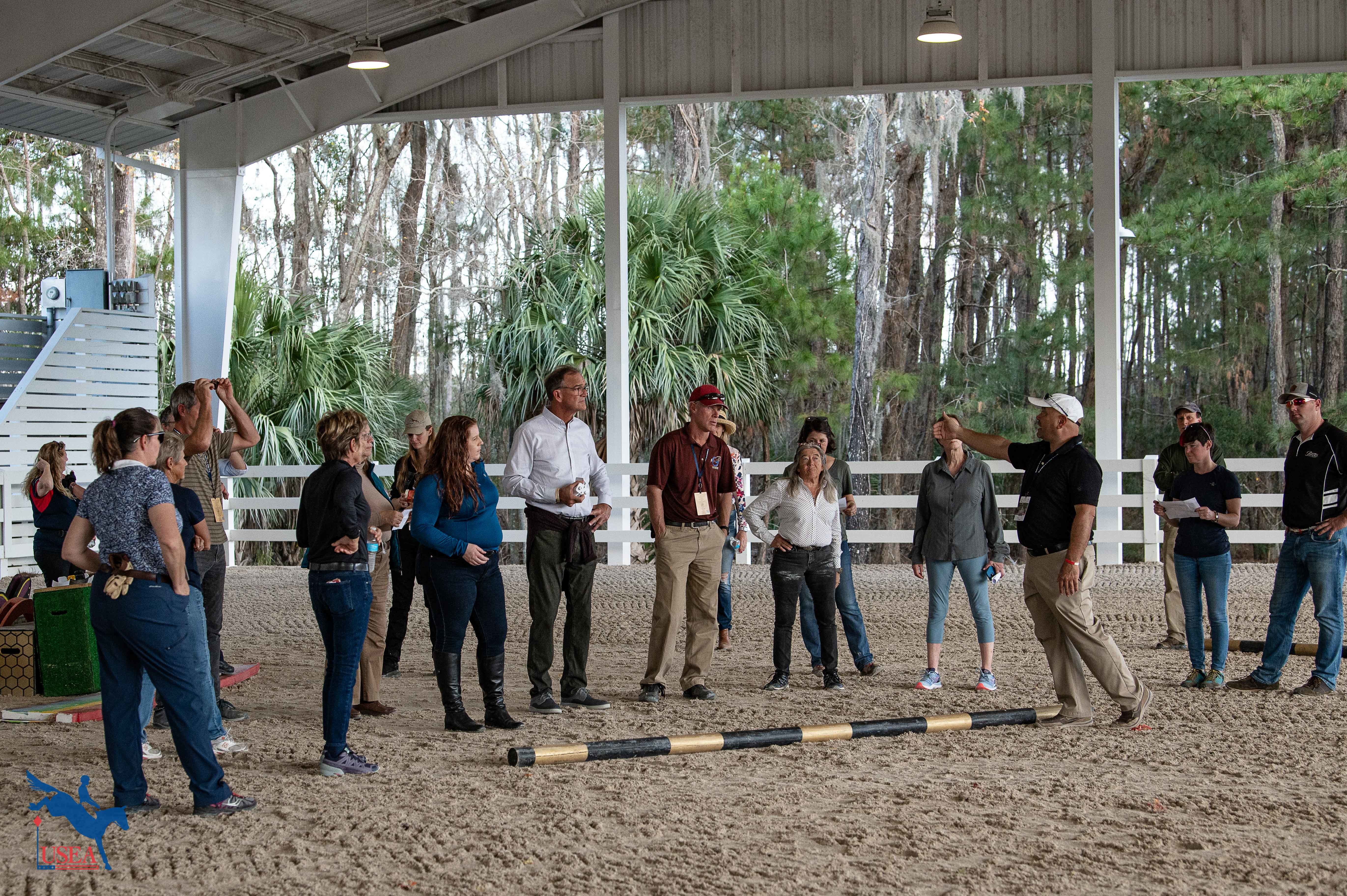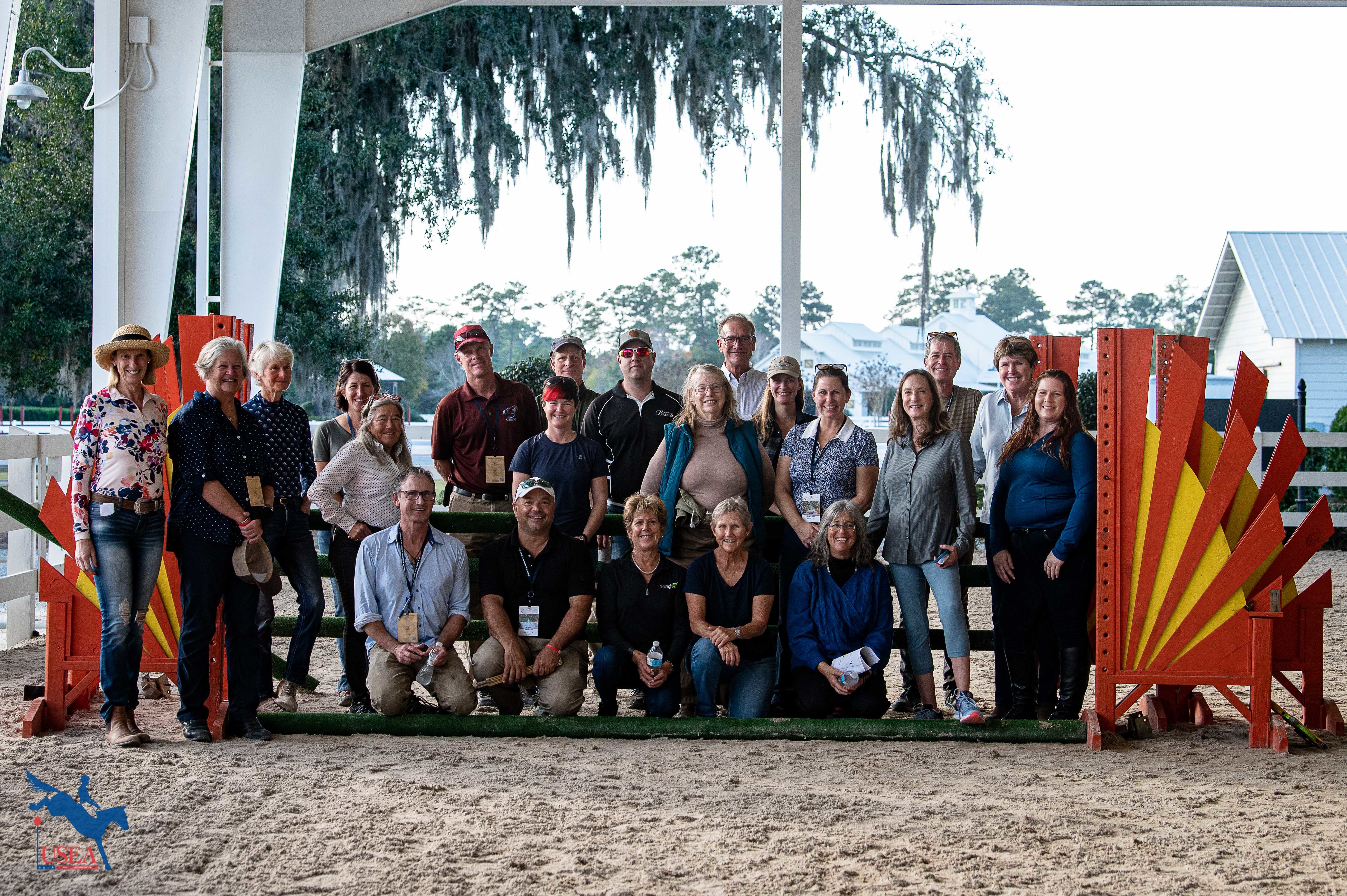

Show jumping: there is so much more to it than just setting out a set number of jumps in a ring. Professional course designers Marc Donovan and Chris Barnard broke down the fine details that come with show jumping course design during the Show Jumping Building Seminar which kicked off the 2022 USEA Annual Meeting & Convention on Wednesday, December 7th in Savannah, Georgia. With an in-classroom session discussing rules, regulations, theory, and more, followed by a practical hands-on course building session held at the Savannah College of Art and Design (SCAD) Ronald C. Waranch Equestrian Center where participants were able to put all of the morning’s education to work, this year’s Show Jumping Course Building Seminar was full of useful information for both eventing lovers and course design hopefuls alike.
In the morning session, both presenters broke down key factors to consider when building courses which Donovan narrowed down to five points: the lines, distances, the level of difficulty, and the purpose of the course is.

But of course, the role of the course designer doesn’t end there. “As a course designer you have a lot of responsibility to different parts of the show,” commented Donovan. “First and foremost is the horse. You have to be thinking of horse welfare number one. You have the obligation to the rider to provide a course that serves as a training tool. Then, different events have varying needs and wants, so you need to check in with the event manager to ensure you are working along their lines. You have to consider the spectators– you need a course that can be viewed from every angle from where the spectators are seated. Events cannot run without sponsors, so you need to work with sponsor signage and jumps and make sure it is visible at all points of the ring. And the cause - if an event has a theme or a cause they are running for, you need to make sure that message is visible on course as well.”
Donovan laid out the five things to consider when you begin building your track: safety, sport, training, suitability, and daylight. He and Barnard went over the impacts of filler, the body mechanics of a horse and how to utilize that information when setting strides throughout, the way that things such as the color of the poles against varying footings or in indoor/outdoor environments can affect horse perception, and how to best utilize the material made available to you to set up an appropriate and attractive course design during the classroom session. Planning out turns and wheeling accordingly, working with arena size, scoring faults on course, and so much more were also introduced for discussion.
“The most important part of our job is to build a fair test for everybody,” reflected Barnard. “We are not looking to build a Preliminary course for Beginner Novice. What you use in the jump and where you use it can make the course a lot more difficult. The questions that you use have to come with that in mind.”
According to Barnard, a good course features:
To evaluate your success post-event, Barnard suggested analyzing the statistics related to the course and narrowing down on any trouble areas that didn’t stand out as potentially difficult parts of the course upon your initial build.

The interactive first part of the seminar allowed participants to ask the important questions at the start of the day, before applying what they learned in the practical session later on. While onsite at the SCAD Ronald C. Waranch Equestrian Center both Donovan and Barnard applied the information in real-life, hands-on situations. The first prime example was that the arena set aside for the seminar was actually a bit smaller than the measurements provided to the course designers beforehand. This, according to Donovan, is an occurrence that all course designers will experience throughout their careers and they need to be prepared to adjust as necessary when on-site. They discussed the importance of measuring your distances from the edge of the ring to the start of your standard and utilizing 10’ poles when appropriate in small arena settings to create a course that will be successful for both horse and rider.
Participants began constructing jumps set for the Advanced level and discussed combinations, oxers, and setting triple bars. From there, Barnard had all of the participants line up at the same starting point and walk a five-stride line. Everyone’s landing point varied, with most participants ending up within 10 meters of one another. This emphasized the importance of measuring and perfecting your ability to walk a distance as a course designer to ensure that measurements are always spot on.
“I always learn something every time I teach one of these. It was great, everyone was really into it and enthusiastic and we all had a great time,” reflected Donovan at the end of the clinic. He elaborated that this year’s group asked some wonderful questions, specifically related to what can actually happen on course in relation to turns and other things and that he also found himself absorbing some new useful information and ideas through the open discussion, further solidifying the importance of seminars such as this one as a continuing education tool for established course designers and potential hopefuls alike.

“Marc and I have so much experience in eventing show jumping,” shared Barnard. “If we can give this group our knowledge then it improves the sport, whether they are trainers, riders, officials, or are hoping to be officials, they can take our knowledge and use it at a horse show, in their judging, or their course walking. I like to share what I have learned with people who want to hear it. I think that is the nice thing about these educational things. These individuals are here to learn and they get the experience, and there is nothing better for them to take away and use for themselves than that.”
Still riding high on the excitement of the 2024 Defender Kentucky Three-Day Event? So are we! One of the most exciting parts about the event is getting to watch, and sometimes meet, your eventing idols up close and in person. This year, the Kentucky team put together a group of really fun "behind the barn" videos with both four- and five-star competitors to help you get to know them a little bit better.
It was a weekend to remember at the 2024 Defender Kentucky Three-Day Event. Special stories were plentiful, with Oliver Townend taking his fourth Kentucky win in his 100th career five-star start, horses like Sharon White's Claus 63 and Liz Halliday's Cooley Nutcracker completing their first five-stars, and fan favorites like Mia Farley and Phelps and Lauren Nicholson and Vermiculus impressing.
Pierre Le Goupil, a former elite-level eventing athlete, turned decorated course designer in charge of designing the eventing course at this year’s Paris Olympics, has been appointed the new cross-country course designer for the MARS Maryland 5 Star at Fair Hill presented by Brown Advisory, beginning in 2025.
The USEA is saddened to share that the Kent Horse Trials in Kent, Connecticut, will be ending its run after 44 years. This USEA Area I event has been a historical staple in the eventing community since its first event ran in 1980. This decision was not made lightly by the organizing committee, but the team behind the Kent Horse Trials cited various challenges which led to this decision.